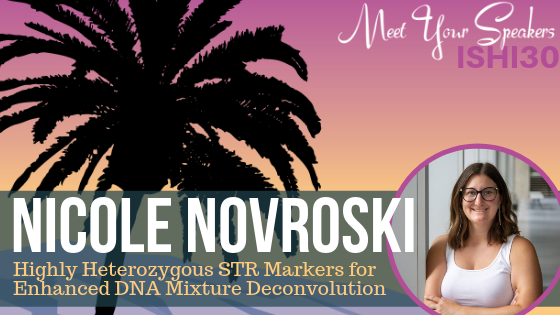De-convolution of complex mixtures can be challenging. Various improvements in polymerase chain reaction coupled with capillary electrophoresis (PCR-CE) and massively parallel sequencing (MPS) chemistries coupled with downstream statistical analyses have been developed and implemented to better resolve two or more person DNA mixtures. However, current genotyping outputs describe STR variation solely based on allele size and do not exploit the full genetic information contained within target markers to distinguish between or among component contributors.
In her presentation at ISHI, Nicole will highlight an exploratory study of a multiplex comprised of 73 highly polymorphic STRs from individuals comprising three US populations. We chatted with Nicole to discuss the challenges that exist with reproducibility in mixture interpretation and how MPS can help.
What are the challenges that exist with reproducibility in mixture interpretation?
Pulling from the understanding that every case is different, every DNA mixture is different. The number and ratio of contributors in the sample will vary, the quality and quantity of biological evidence recovered will vary, and the DNA typing process can influence the resultant DNA profile(s) due to variability in the human, chemistry and technological components within the DNA typing workflow. So, the interpretation of DNA mixtures continues to remain one of the most challenging aspects within forensic biology. With the increased implementation of probabilistic genotyping in crime labs around the world, we can now have more confidence in our interpretations, but like everything else, the output is only as good as the input, and there may be discordance in how a profile is interpreted between individuals, labs, and the forensic community.
How can massively parallel sequencing (MPS) assist with deconvoluting a mixture? Are there any challenges that still remain?
In my opinion, MPS offers many advantages over PCR-CE when approaching DNA mixture samples, including the ability to determine the nucleotide sequences of each allele, identify sequence-based differences between alleles of the same length, and quantify (to some degree) the contributions of each allele at each locus in the sample. Greater confidence in the true number of alleles present in a mixed DNA sample will aid in the interpretation of the mixed DNA profile(s) and facilitate statistical calculations.
But yes, several challenges still remain. As we learn about sequence diversity, we are faced with novel challenges regarding stutter, noise and artifacts associated with the new technologies. New instrumentation also means the establishment of new thresholds and validation(s). The silver lining? With new labs bringing the MPS technology online, the validations will come, and MPS will (one day) be as routine as PCR-CE.
Can you briefly describe the study that you’ll be presenting at ISHI?
My talk at ISHI will focus on a multiplex of highly heterozygous STR markers that are capable of enhanced DNA mixture deconvolution. This project was a multi-year endeavor that explored thousands of potential genomic targets and utilized multiple chemistry approaches. At the end of the day, I had a multiplex with 73 STRs that showed promise for forensic applications. A subset of 20 markers was selected for comparison to the CODIS core loci, and we found that the new markers were capable of complete DNA mixture deconvolution in a subset of 2-person mixtures. So, all alleles at all loci in these resolved mixtures could be determined. Why is this important? Well, if the individuals in the mixed DNA sample share fewer (or no) alleles at each locus in the multiplex, the more informative the genotyping of those markers will be. And that is our (my) end goal – to develop a multiplex that has the capabilities of multi-person mixture deconvolution simply by exploiting the natural genetic diversity that exists between individuals.
How did this case study come to fruition? How did you become involved?
This study was the major focus of my doctoral research at UNTHSC’s Center for Human Identification and was supported by a National Institute of Justice grant (2015-DN-BX-K067; Enhancing Mixture Interpretation with Highly Informative STRs) as part of a larger project in Dr. Bruce Budowle’s research laboratory to improve DNA mixture deconvolution capabilities.
Did any surprises arise during the course of the study?
Oh yes! Research is always full of surprises! We identified thousands of potential targets, where hundreds of these markers may be the answer to all of our questions… but we still have to work within the constraints of current chemistries and technologies, which drastically narrow our exploratory capabilities. Since I originally started the project, big changes have been made to targeted sequencing using MPS, so I can now continue to explore new markers as I move forward.
Second, there are a lot of groups generating human genome data, and a lot of different alignment tools are used to rebuild the sequence data. This of course has led to a diversity of sequence alignments being uploaded into public databases, and some discordance between different records. For one locus in particular, D10S1237, we identified an insertion that was common in only a subset of the alleles, causing major discrepancies in the dbSNP record for the locus. So, that was a neat finding, and something I published in 2018.
Finally, I think the most impressive finding that I discovered was how informative some of the originally selected markers truly are. If we think about what little knowledge about sequence diversity was known back when the original CODIS core loci were selected, it is truly impressive at how informative (genetically and statistically) some of the markers are, even in the advent of improved chemistries and technologies.
What has been your biggest takeaway?
This study really uncovered the true complexity of the human genome and such a rich diversity of microsatellites contained within it. I really think that our approach to DNA mixtures can be substantially improved in the coming years by incorporating additional (more informative) genomic targets, coupled with all of the newer and up-and-coming technologies.
What tips would you give to someone who is just starting out in the field of forensics, or what is the best advice that you’ve received?
Work hard, be humble, and take chances. I know that might sound a bit cliché, but hard work always pays off. In the past decade (since I finished my undergraduate degree), I left my small town in Canada and have moved about a dozen times; whether it was for a job, my Master’s degree, an internship, another job, my PhD, or now back “home” in my position as a tenure-stream faculty member at the University of Toronto. With every move (every risk), there was an opportunity for something incredible, and each venture opened the door to bigger and better possibilities! The job market can be volatile, and the world is a very competitive place – so, if you have the courage and the flexibility to do so, go after the things in life that you really want. You will not be sorry! Worst-case scenario, you can always go back home (or back to where it is you came from). My journey has definitely been unique, but I am thankful every day for the decisions and risks that led me to where I am today!
As we celebrate the 30th anniversary of ISHI, do you have any predictions for what the future holds or do you have any fond memories of using older technologies/techniques?
We are living in a really interesting time for forensic genetics. The new capabilities of rapid DNA testing, phenotyping and genetic genealogy have opened up so many new possibilities for forensic investigations, and in turn, have created a whirlwind of potential concern and panic regarding genetic privacy and legislation. In the next few years, I think we will see a lot of admissibility hearings and challenges in court. Overall, my prediction is that the field of forensic genetics will continue to evolve, and in a short time, I think we will overcome many of the current challenges faced by analysts in both the generation and interpretation of complex forensic DNA profiles and investigations.
What’s one thing that others may not know about you?
People often compliment me on being so outgoing… and I love that, but the truth is, I’m really a big introvert! I often use comedy and exercise as my strategies to put myself out there and engage with others in an enjoyable way! So, if you ever need a good joke, I have a ton of great ones!
WOULD YOU LIKE TO SEE MORE ARTICLES LIKE THIS? SUBSCRIBE TO THE ISHI BLOG BELOW!
SUBSCRIBE NOW!



